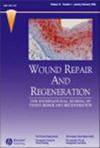Teleconsulting in wound care: Connecting the primary care to the wound specialist reduces unnecessary referrals
IF 3.8
3区 医学
Q2 CELL BIOLOGY
引用次数: 0
Abstract
In the Netherlands the primary care (General Practitioner or homecare nurse) encounter a variety of wounds ranging from traumatic to diabetic foot ulcers. According to a recent study 82.4% of the patients with a wound can be treated in a primary setting with the GP as medical supervisor. The remaining 17.6% of patients need more extensive care including advice by a specialised doctor, diagnosis and treatment. Prompt analyses and treatment of underlying causes by specialised doctors in a multidisciplinary setting is necessary for treating patients with complicated wound. This article describes the impact of Electronic Health Consultation on all wounds treated in the primary care. And describes the effect on the duration until referral to the hospital and the influence on the amount of unnecessary referrals to the hospital. All data was collected prospectively from June 2020 until October 2021. The study involved a process where primary care could seek advice from a Wound Physician at the Alrijne Wound Centre through a specialised Electronic Health Consultation. A total of 118 patients were analysed. 41/118 (34.7%) patients required a physical consultation with analysis and treatment in the hospital, after teleconsultation. The remaining 77/118 (65.3%) could be treated in primary care after Electronic Health Consultation. The mean duration of wound existence until Electronic Health Consultation was 39.3 days (range 5–271, SD: 38.5). 3/41 (7.3%) of the referrals were unnecessary. Electronic Health Consultation serves as a valuable and efficient tool for enhancing wound care, ultimately contributing to improved patient management and resource allocation within the healthcare system. This article describes the impact of Electronic Health Consultation on all wounds treated in the primary care and the influence on the duration until referral to the hospital and the influence on the amount of unnecessary referrals to the hospital.伤口护理方面的远程咨询:将初级保健与伤口专科医生联系起来,减少不必要的转诊
在荷兰,基层医疗机构(全科医生或家庭护理护士)会遇到从外伤到糖尿病足溃疡等各种伤口。根据最近的一项研究,82.4%的伤口患者可以在全科医生的指导下在基层医疗机构得到治疗。其余 17.6% 的患者则需要更广泛的护理,包括专科医生的建议、诊断和治疗。在治疗复杂伤口患者时,有必要由专科医生在多学科环境下对潜在病因进行及时分析和治疗。本文介绍了电子健康咨询对基层医疗机构治疗的所有伤口的影响。并描述了电子健康咨询对转诊到医院的时间的影响,以及对不必要转诊到医院的数量的影响。所有数据都是在 2020 年 6 月至 2021 年 10 月期间进行的前瞻性收集。研究过程中,基层医疗机构可通过专门的电子健康咨询向阿尔里耶恩伤口中心的伤口医生寻求建议。共对 118 名患者进行了分析。41/118(34.7%)名患者需要在远程会诊后到医院进行分析和治疗。其余 77/118 名患者(65.3%)可在电子健康咨询后在基层医疗机构接受治疗。在接受电子健康咨询之前,伤口存在的平均时间为 39.3 天(范围为 5-271,标准差:38.5)。3/41(7.3%)的转诊是不必要的。电子健康咨询是加强伤口护理的重要而有效的工具,最终有助于改善医疗系统内的患者管理和资源分配。本文介绍了电子健康咨询对基层医疗机构治疗的所有伤口的影响,以及对转诊至医院的时间和不必要的转诊量的影响。
本文章由计算机程序翻译,如有差异,请以英文原文为准。
求助全文
约1分钟内获得全文
求助全文
来源期刊

Wound Repair and Regeneration
医学-皮肤病学
CiteScore
5.90
自引率
3.40%
发文量
71
审稿时长
6-12 weeks
期刊介绍:
Wound Repair and Regeneration provides extensive international coverage of cellular and molecular biology, connective tissue, and biological mediator studies in the field of tissue repair and regeneration and serves a diverse audience of surgeons, plastic surgeons, dermatologists, biochemists, cell biologists, and others.
Wound Repair and Regeneration is the official journal of The Wound Healing Society, The European Tissue Repair Society, The Japanese Society for Wound Healing, and The Australian Wound Management Association.
 求助内容:
求助内容: 应助结果提醒方式:
应助结果提醒方式:


